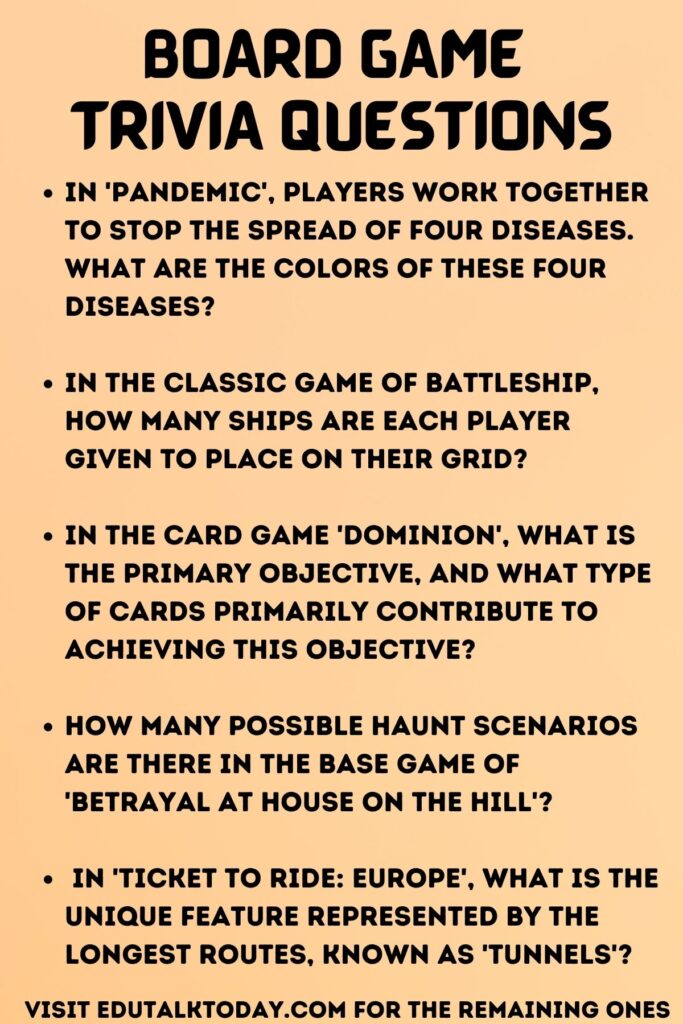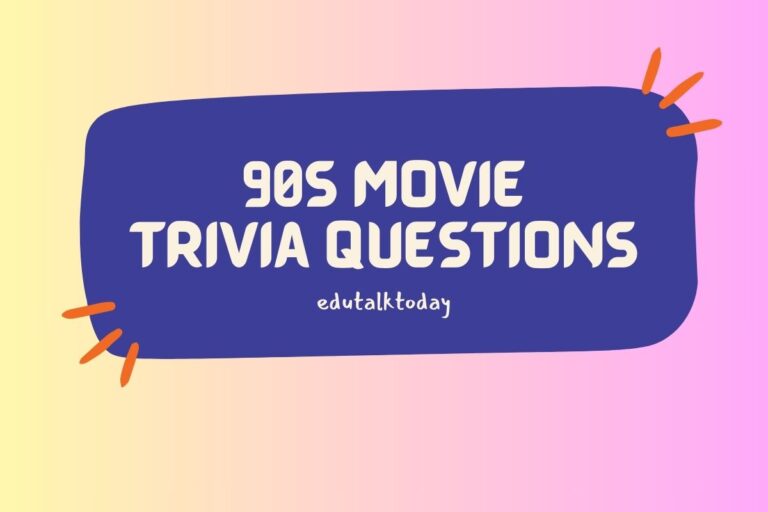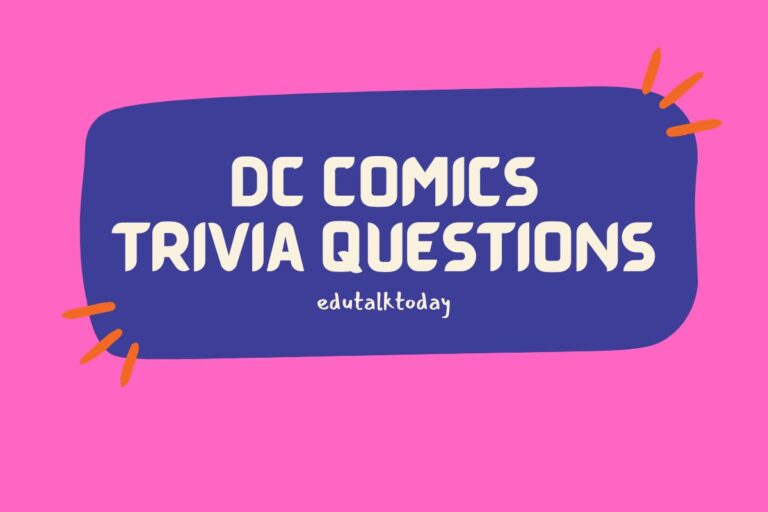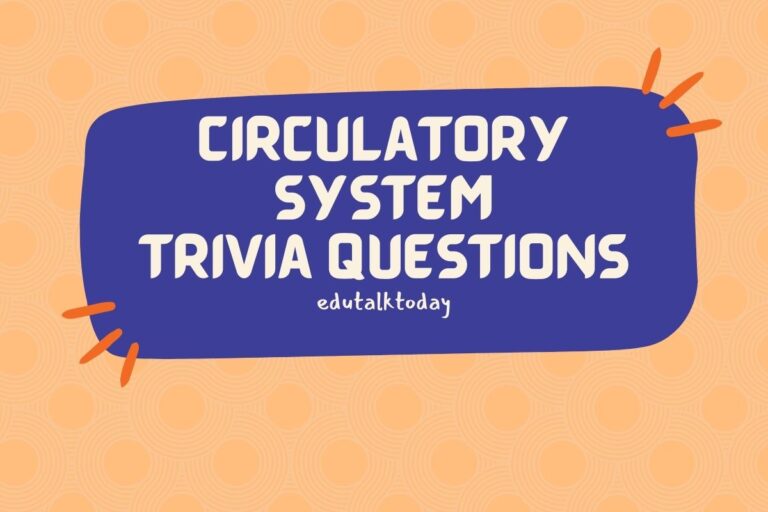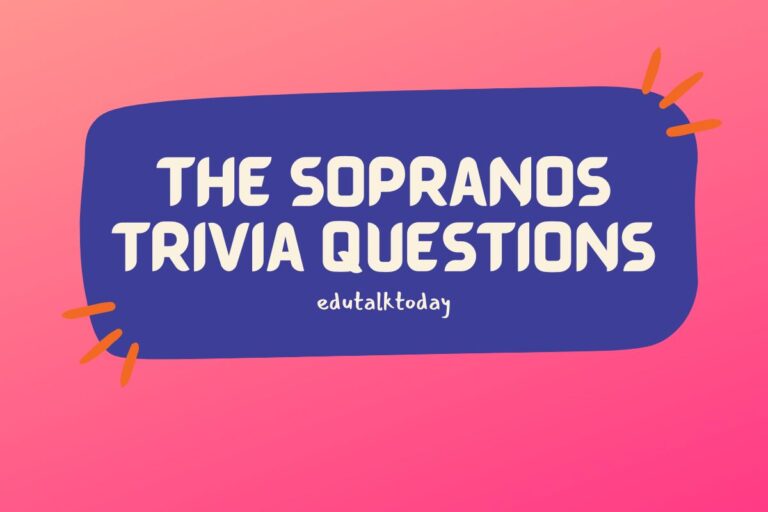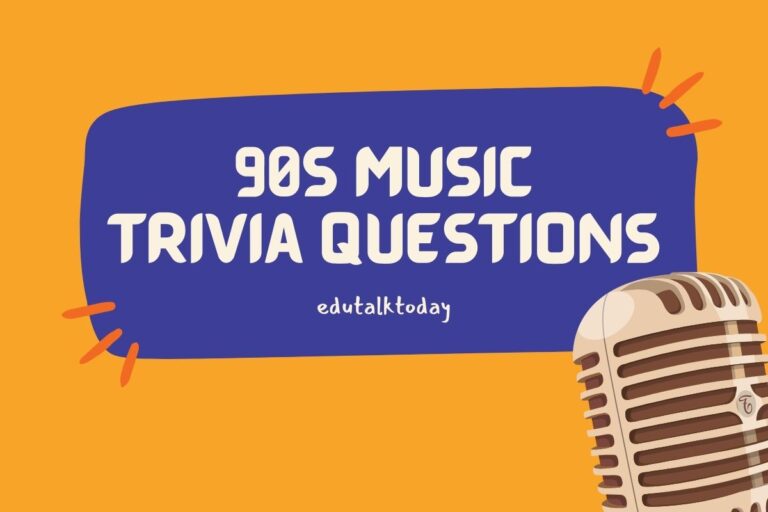48 Board Game Trivia Questions

Board games have long been a beloved pastime, offering not only entertainment but also a way to challenge our minds, strategize, and even learn something new.
Over the years, board games have evolved, with a rich history and an array of interesting facts that appeal to enthusiasts and casual players alike.
In this blog, we delve into the world of board games through some intriguing trivia questions. These questions are designed to test your knowledge and perhaps reveal some surprising facts about these classic games.
Whether you’re a seasoned gamer or just enjoy the occasional friendly match, these trivia questions promise to entertain and enlighten.
So,let’s roll the dice and begin.
Board Game Trivia Questions
- Settlers of Catan: In the game ‘Settlers of Catan’, what are the five resources players collect and use to build roads, settlements, and cities?
- Monopoly: In a standard Monopoly game, what are the names of the four railroads?
- Chess: What is the name of the maneuver in chess where a player moves their king two squares towards a rook on the player’s first rank, then the rook moves to the square over which the king crossed?
- Risk: In the game of Risk, which continent has the highest value for additional armies due to its difficulty to defend?
- Scrabble: What is the highest-scoring word in Scrabble, assuming no double or triple word score tiles are used, and what is its point value?
- Pandemic: In ‘Pandemic’, players work together to stop the spread of four diseases. What are the colors of these four diseases?
- Clue (Cluedo): In the original version of the game ‘Clue’ (or ‘Cluedo’), what are the six potential murder weapons?
- Twilight Struggle: ‘Twilight Struggle’ is a board game simulating the Cold War. Which two countries represent the two superpowers in this game?
- Ticket to Ride: In the original U.S. version of ‘Ticket to Ride’, which two cities are connected by the longest continuous path, and how many train cars is this path worth?
- Carcassonne: In ‘Carcassonne’, players build a medieval landscape using tiles. What are the four types of areas that can be scored?
- Trivial Pursuit: In ‘Trivial Pursuit’, what are the six categories of questions?
- The Game of Life: In ‘The Game of Life’, what are the two paths players can choose at the start of the game?
- Battleship: In the classic game of Battleship, how many ships are each player given to place on their grid?
- Dominion: In the card game ‘Dominion’, what is the primary objective, and what type of cards primarily contribute to achieving this objective?
- Jenga: In the game of Jenga, how many blocks are used to start the tower?
- Axis & Allies: In ‘Axis & Allies’, which five powers are the major players in the game, representing the two sides of World War II?
- The Resistance: In the game ‘The Resistance’, what are the two teams that players belong to?
- Agricola: In ‘Agricola’, players are farmers who must build up their farms. What are the four main types of animals featured in the game?
- Betrayal at House on the Hill: How many possible haunt scenarios are there in the base game of ‘Betrayal at House on the Hill’?
- Power Grid: In ‘Power Grid’, players compete to supply cities with power. What are the four types of power plants available?
- 7 Wonders: In the game ‘7 Wonders’, players build their civilizations through three ages. What are the three main types of cards used to construct your civilization?
- Gloomhaven: ‘Gloomhaven’ is a popular cooperative board game with a campaign-style play. What is the primary objective for players in this game?
- Munchkin: In the game ‘Munchkin’, players compete to reach what level first?
- Splendor: In ‘Splendor’, players are merchants of the Renaissance trying to buy gem mines, means of transportation, and shops. What are the five types of gemstones represented in the game?
- Ticket to Ride: Europe: In ‘Ticket to Ride: Europe’, what is the unique feature represented by the longest routes, known as ‘tunnels’?
- King of Tokyo: In ‘King of Tokyo’, players battle as monsters trying to control Tokyo. How do players win the game?
- Codenames: In ‘Codenames’, what is the role of the ‘Spymaster’, and how many teams compete in the game?
- Catan: Seafarers: In the ‘Seafarers’ expansion of ‘Settlers of Catan’, what additional element is introduced to the game, and what is its primary function?
- Small World: In ‘Small World’, players vie for conquest and control of a world that is too small to accommodate everyone. What unique feature do the game pieces have?
- Eldritch Horror: In ‘Eldritch Horror’, players work together to solve mysteries and fight monsters. What is the ultimate goal of the game?
- Mansions of Madness: In ‘Mansions of Madness’, what role does one player take on, separate from the other players?
- Uno: In the card game Uno, what happens when a player fails to yell “Uno” upon having only one card left?
- Carcassonne: Hunters and Gatherers: In the ‘Hunters and Gatherers’ version of ‘Carcassonne’, what are the three primary types of terrain players can place their meeples on?
- Forbidden Island: In ‘Forbidden Island’, players work together to collect treasures. What are the four treasures?
- Magic: The Gathering: In ‘Magic: The Gathering’, what are the five colors of mana, and what general aspect does each color represent?
- Dixit: In ‘Dixit’, how do players score points?
- Blokus: In the game ‘Blokus’, how many pieces does each player start with, and what is the main rule for placing pieces on the board?
- Puerto Rico: In ‘Puerto Rico’, players assume the roles of colonial governors. What are the three primary goods produced in the game?
- Terra Mystica: In ‘Terra Mystica’, players govern one of 14 factions trying to terraform the landscape. What is the unique aspect of each faction?
- The Castles of Burgundy: In ‘The Castles of Burgundy’, players build estates in medieval France. What mechanism determines the actions a player can take each turn?
- Stone Age: In ‘Stone Age’, a game about early human civilizations, what are the main resources players collect?
- RoboRally: In ‘RoboRally’, players program robots to navigate through a factory floor. What unique challenge does the factory floor pose?
- Ticket to Ride: Asia: In the ‘Team Asia’ version of ‘Ticket to Ride: Asia’, how do players work together differently compared to the standard game?
- Pictionary: In the game ‘Pictionary’, what are the five categories of things players must draw?
- Tigris and Euphrates: In ‘Tigris and Euphrates’, a game set in ancient Mesopotamia, what are the four types of tiles players use to build civilizations?
- Azul: In ‘Azul’, players are tile-laying artists decorating a palace. What are the five colors of tiles available?
- Galaxy Trucker: In ‘Galaxy Trucker’, players build space trucks and navigate them through challenges. What are the three phases of each round?
- The Mind: ‘The Mind’ is a cooperative card game. What is unique about the communication rules between players?
Answers
- Settlers of Catan: The five resources are wood, brick, wool, grain, and ore.
- Monopoly: The four railroads are Reading Railroad, Pennsylvania Railroad, B&O Railroad, and Short Line.
- Chess: The maneuver is called ‘castling’.
- Risk: Asia offers the highest value for additional armies.
- Scrabble: The highest-scoring word is ‘OXYPHENBUTAZONE’, which can theoretically score up to 1,778 points.
- Pandemic: The disease colors are blue, yellow, black, and red.
- Clue (Cluedo): The six weapons are a candlestick, dagger, lead pipe, revolver, rope, and wrench.
- Twilight Struggle: The two superpowers are the United States and the Soviet Union.
- Ticket to Ride: The longest continuous path is between Los Angeles and Miami, worth 20 train cars.
- Carcassonne: The four areas are cities, roads, fields, and monasteries.
- Trivial Pursuit: The six categories are Geography, Entertainment, History, Arts & Literature, Science & Nature, and Sports & Leisure.
- The Game of Life: The two paths are ‘College’ and ‘Career’.
- Battleship: Each player is given 5 ships.
- Dominion: The primary objective is to acquire the most victory points, primarily through Victory cards.
- Jenga: 54 blocks are used to start the tower.
- Axis & Allies: The major powers are Germany, Japan, the United Kingdom, the Soviet Union, and the United States.
- The Resistance: The two teams are the Resistance (rebels) and the Spies (government informants).
- Agricola: The four types of animals are sheep, wild boar, cattle, and horses.
- Betrayal at House on the Hill: There are 50 possible haunt scenarios in the base game.
- Power Grid: The four types of power plants are coal, oil, garbage, and nuclear.
- 7 Wonders: The three types of cards are Resource cards, Military cards, and Civilian Structure cards.
- Gloomhaven: The primary objective is to complete various scenarios that contribute to an overarching story.
- Munchkin: Players compete to reach level 10 first.
- Splendor: The five types of gemstones are diamond, sapphire, emerald, ruby, and onyx.
- Ticket to Ride: Europe: Tunnels may require players to play extra cards to complete the route, simulating the uncertainty of tunnel construction.
- King of Tokyo: Players can win by either accumulating 20 victory points or being the last monster standing after defeating all others.
- Codenames: The Spymaster gives one-word clues to guide their team to guess the words of their color. There are two teams competing.
- Catan: Seafarers: This expansion introduces ships, which are used to travel across water and explore new islands.
- Small World: The game pieces represent different fantasy races, each with its own unique powers and abilities.
- Eldritch Horror: The goal is to solve mysteries and defeat the Ancient One before it awakens and destroys the world.
- Mansions of Madness: One player takes on the role of the ‘Keeper’, controlling the monsters and creating the story’s narrative.
- Uno: If a player fails to yell “Uno” and gets caught, they must draw additional cards as a penalty.
- Carcassonne: Hunters and Gatherers: Players can place meeples on rivers, forests, and meadows.
- Forbidden Island: The four treasures are The Earth Stone, The Statue of the Wind, The Crystal of Fire, and The Ocean’s Chalice.
- Magic: The Gathering: The five colors are White (order, law), Blue (intellect, logic), Black (power, self-interest), Red (freedom, emotion), and Green (nature, life).
- Dixit: Points are scored when players guess the storyteller’s card or when other players guess a card that is not the storyteller’s, leading to a blend of creativity and strategy in guessing and storytelling.
- Blokus: Each player starts with 21 pieces. Pieces must touch at least one other piece of the same color, but only at the corners.
- Puerto Rico: The three primary goods are coffee, sugar, and tobacco.
- Terra Mystica: Each faction has unique abilities and a preferred type of terrain for settlement.
- The Castles of Burgundy: Players use dice rolls to determine their available actions each turn.
- Stone Age: The main resources are wood, brick, stone, gold, and food.
- RoboRally: The factory floor includes conveyor belts, lasers, and pits, which can damage or disrupt the robots.
- Ticket to Ride: Asia: In ‘Team Asia’, players share trains and routes with a teammate, but they have separate hands of cards.
- Pictionary: The categories are Object, Person/Place/Animal, Action, Difficult, and All Play.
- Tigris and Euphrates: The four types of tiles are temples, markets, farms, and settlements.
- Azul: The tile colors are blue, yellow, red, black, and turquoise.
- Galaxy Trucker: The three phases are building the space truck, flying the space truck through space, and scoring based on the journey and truck condition.
- The Mind: Players are not allowed to communicate about the numbers on their cards and must intuitively play cards in ascending order.
